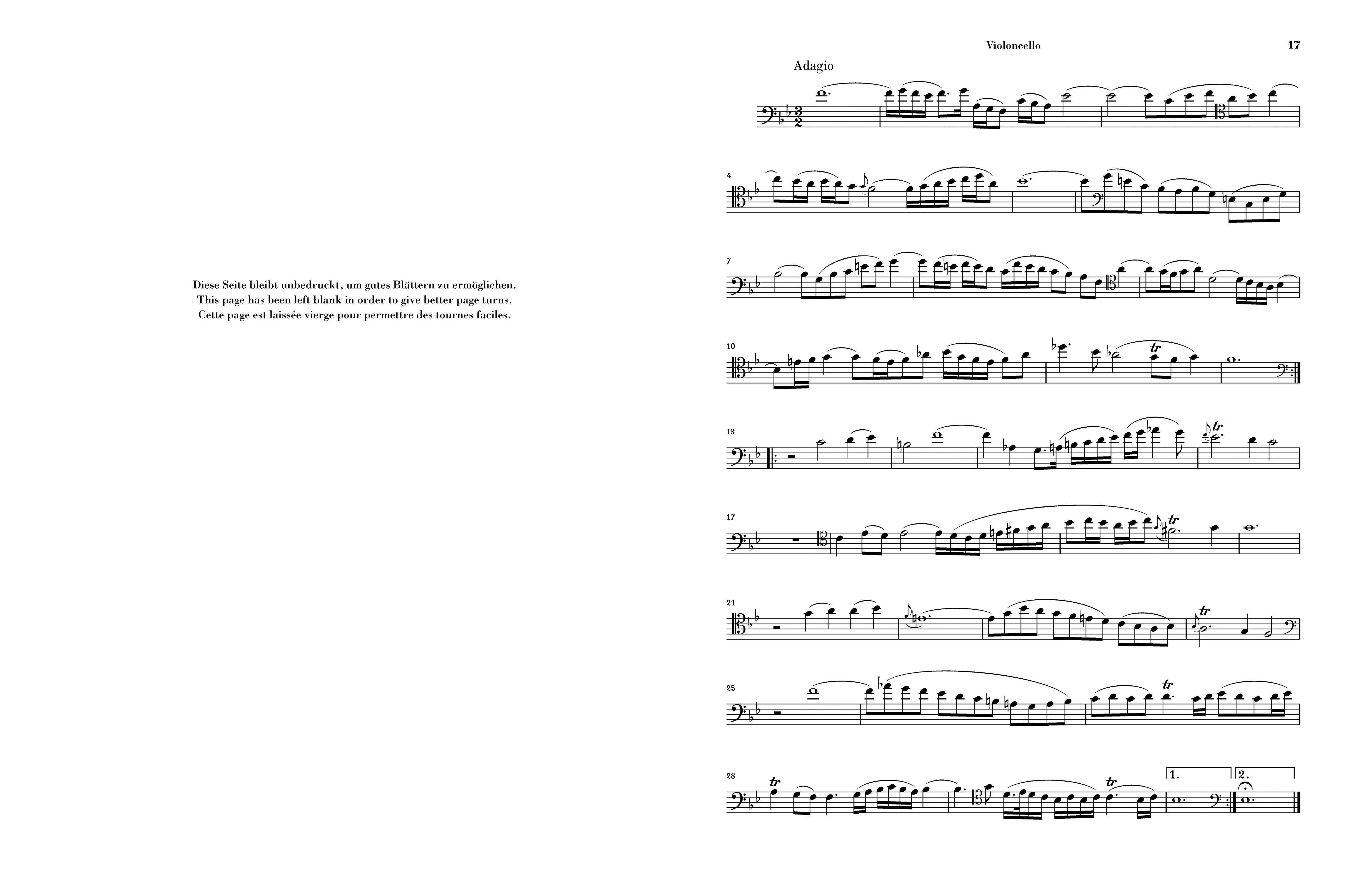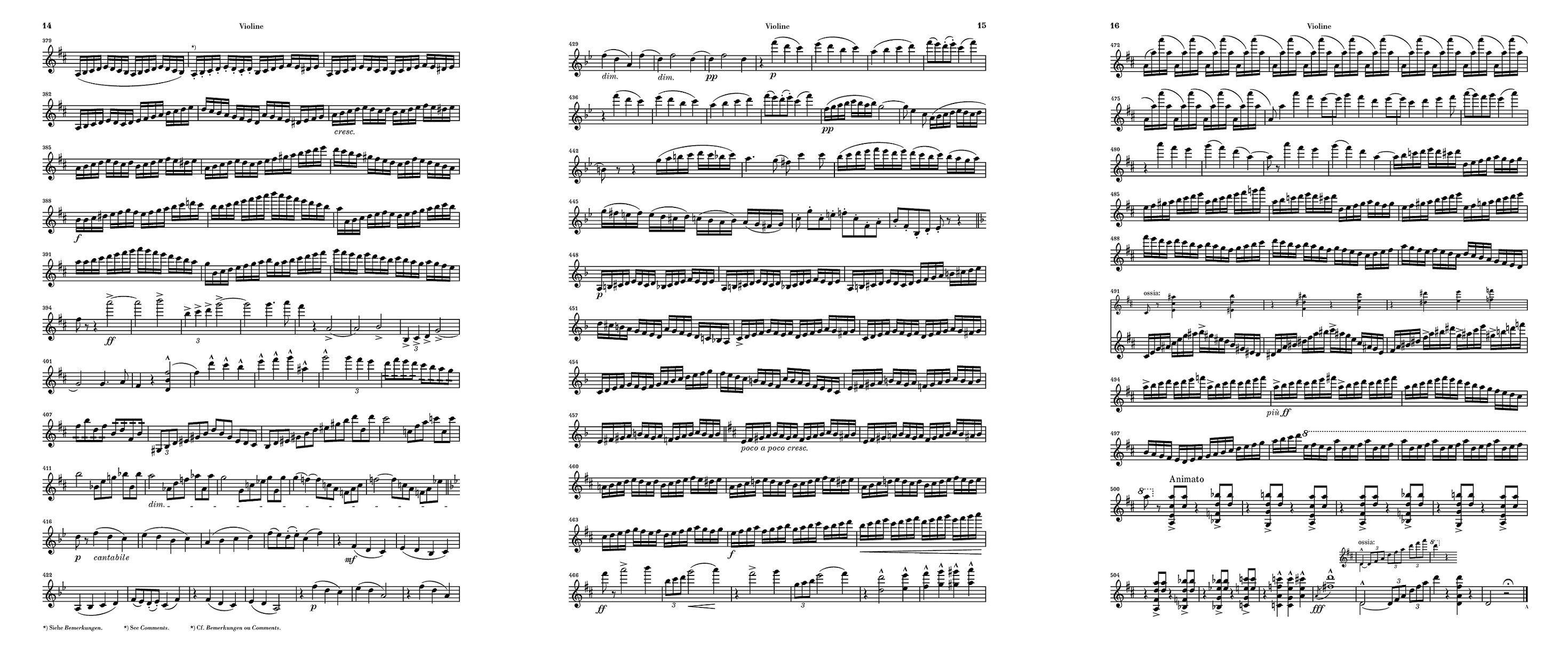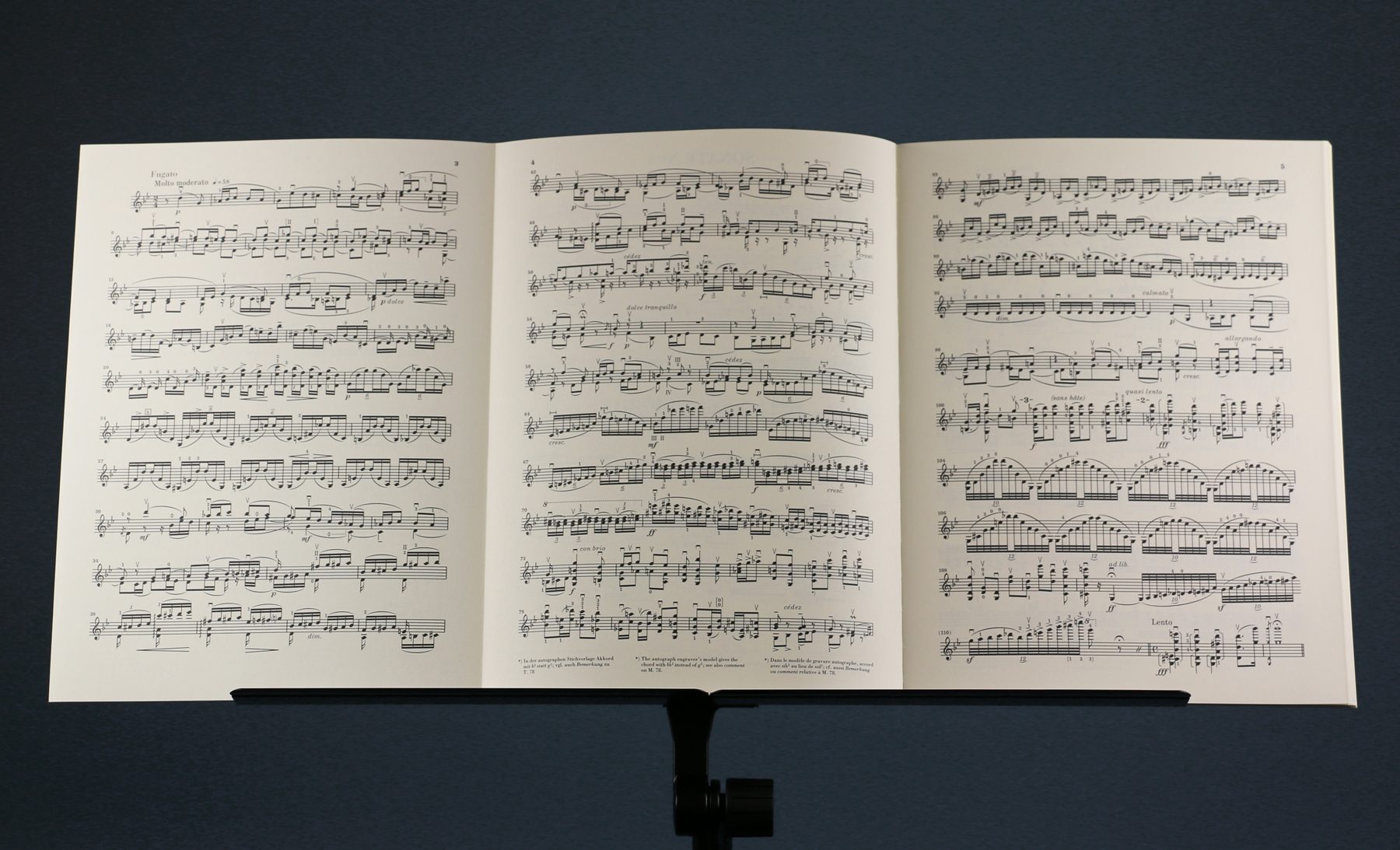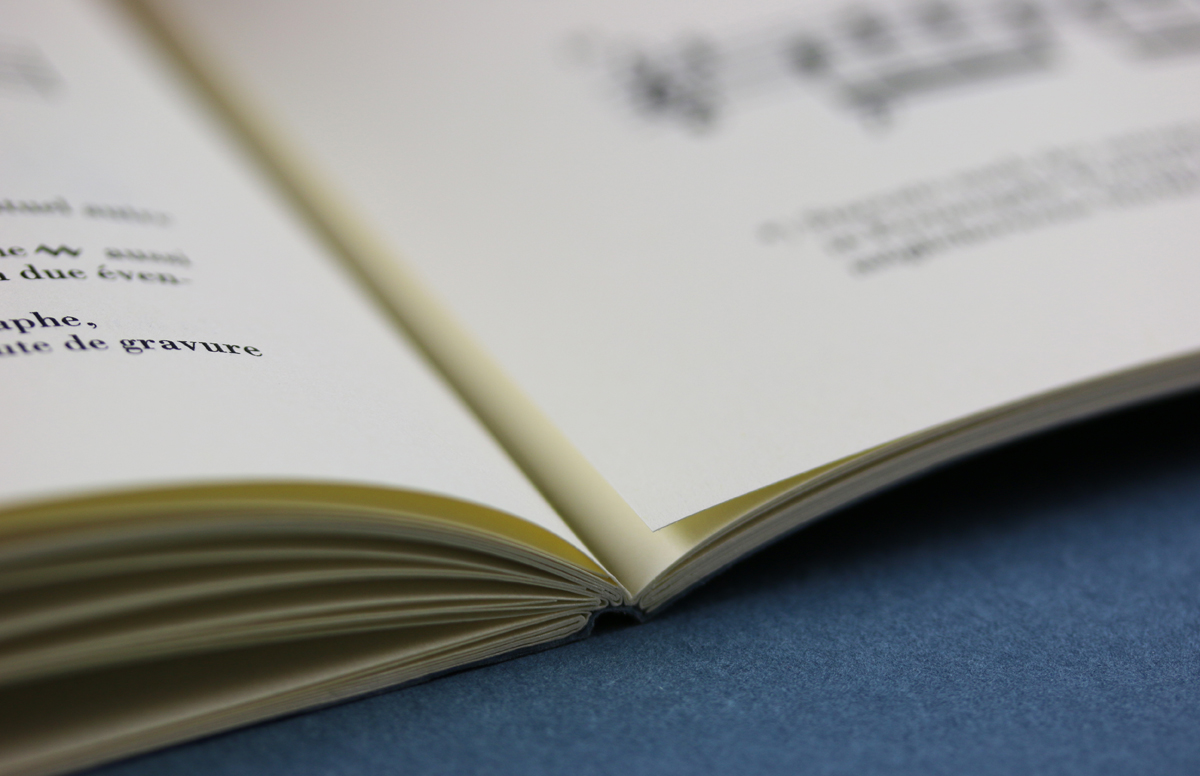 Haven’t you, too, sometimes wondered in a concert why the music that the musicians on stage are using takes such strange forms? Some pianists place on the music rack a big card to which are clipped the complete movements of a Bach suite in scaled-down copies. Even at quartet evenings, pasted-together copies readily hang down off the music stands to the right and left – not to mention lieder recitals, where whole mountains of custom-made fold-up sheets are assembled. The reason for this is obvious: where the music page ends, one either can’t or won’t want to turn the page there. But as an editor of practical Urtext editions, I’m asking myself then, “Isn’t there some other way?”
Haven’t you, too, sometimes wondered in a concert why the music that the musicians on stage are using takes such strange forms? Some pianists place on the music rack a big card to which are clipped the complete movements of a Bach suite in scaled-down copies. Even at quartet evenings, pasted-together copies readily hang down off the music stands to the right and left – not to mention lieder recitals, where whole mountains of custom-made fold-up sheets are assembled. The reason for this is obvious: where the music page ends, one either can’t or won’t want to turn the page there. But as an editor of practical Urtext editions, I’m asking myself then, “Isn’t there some other way?”
Now the more progressive will say perhaps, “Yes, electronically” – and really for years, in fact, music has been worked out electronically with appropriate software for “turning” pages (with, for example, a foot pedal). But this technology is not really ready for the stage. So long as musicians still perform from music on paper instead of on an electronic tablet, we are particularly committed to solving this problem.
And that is the reason why the work on a practical Urtext edition is by no means over when the scholarly-based music text has been prepared. In reality, optimally distributing this music text on the two-page spread, searching for the most suitable page turns for the musicians and – when such is lacking – figuring out special solutions are not only absolutely essential, but sometimes even a most time-consuming task in the production process.
Just the decision about whether the first movement of a sonata is to begin on the right-hand or left-hand page has, indeed, consequences right up to the finale. To be sure, the decision is somewhat less risky today, minimized by modern computer typesetting: Where once the engraved music page could still be altered only with great effort, today the various options can be simulated on-screen. Ideally, the movement will end as a matter of course on a right-hand page or in a duo sonata the violin has several bars of rest while the piano is playing. If that’s not the case, then the situation can occasionally be managed by inserting a blank page to shift the page-turn spot forward or to apportion the subsequent movement better – whereupon we red-flag it with the note, “This page has been left blank in order to give better page turns”.
But what can be done when the solo instrument simply doesn’t have any rests extending to the page-turn? Usually then only one thing can help: the foldout where the two-page spread is expanded by a page that can be unfolded or folded away as required. So, a satisfactory solution could even be found for the closing Allegro molto in our new edition of the 1st violin sonata by Saint-Saëns. This movement in the first edition had mercilessly demanded continuous sixteenths of the violin, with pages to be turned during the one or two quarter-note rests (hardly the blink of an eye at a tempo of a quarter note = 168!). In our new edition the playing momentum is no longer impeded, thanks to a foldout.
Schubert’s great G-major quartet can also be dealt with only by using a foldout, though here there are definitely rests – but these appear at spots dynamically so delicate that turning a page is just not acceptable. And with the solo suites or sonatas by Johann Sebastian Bach, Max Reger or Eugen Ysaÿe, foldouts are virtually indispensable for also being able to play this highly complex music from our editions in concerts.
Even in such cases, however, the production, apart from the music typesetting, is then challenging, for designing an edition with several foldouts on a 16-page printing sheet comes close to resembling a jigsaw puzzle. Binding and cropping, too, present a challenge, for the attached page has to be very quickly, easily and soundlessly unfolded and refolded – needed for this is not only the right paper, but also an absolutely precise folding.
This more costly production is also one of the reasons why the foldout can only ever be an exception and not the rule. Another reason is the simple fact that the foldout makes the page-turn rather difficult: On the one hand, the arm has to reach a long way, on the other, the music page must be subsequently re-aligned so that after turning it is again centred on the music rack. The foldout is hence to be found primarily at the start or at the end of the movement.
To optimally present the music text other solutions now and then arise, such as, for example, in a “leporello”. This fanfold of three or four pages is especially suitable for duo forms where both parts are closely interwoven musically. So, we offer both musicians in Beethoven’s flute duo WoO 26 a score, at the same time avoiding impractical page-turns in the piece.
And now you may perhaps be wondering, “What about the pianists?” Ultimately, Henle is primarily still a publisher of piano music! The answer is sitting on the podium: Pianists are used to having someone beside them in concerts to turn pages. All the same, we do strive for the best possible page-turns – and therefore even sometimes change a layout established for years, as recently with our revision of the Brahms cello sonata in E minor.
The Allegretto quasi Menuetto originally took up two and a half pages here and had quite reasonable page turns in measures 15 and 76. But: after the close of the trio section it was first necessary to turn back two pages for the beginning of the Da Capo and then to turn forward again after only 15 measures – especially disturbing in the concert if the page turner stands up to do this. In order to avoid this in our edition just freshly revised from the music text of the Johannes Brahms Complete Edition, we have arranged this movement on two double-page spreads, and hope in so doing to please pianists, page turners and listeners alike!
Incidentally, it was a musician who brought these weak points to our attention. Do you also have suggestions for improving our editions? Then let us know – we are also doing everything we can in the future to ensure that everything works in our music texts!





Your page turns are one reason you are my favourite publishers.
As a pianist who cannot abide page turners, I was forced to prepare scores in which I could conveniently manage all the turns for chamber works performances myself. This involved all of the devices listed in the original post: blank pages, fold outs etc. I was able to find good turns for every work in the classical canon and never used a page turner. When concert givers urgently called me for student page turners for traveling artists, I would wonder why someone playing the same few works in many concerts would rely on an unknown page turner.
Since these works are played worldwide and pianists everywhere struggle and leave out notes in rehearsals, as well as force the distraction of page turners on audiences, I also wondered why publishers do not offer chamber music scores for pianists that include good page turns. The answer is clear from the article: expense. However, I think that publishers are making a mistake. I would gladly have paid more for an edition that includes excellent page turns, and I think there are many more who would do the same.
Concerning the turns in Henle editions: they could be better. I had to doctor many Henle scores to produce turns that would work in a performance. It is not sufficient to have as many good turns as “possible”, if there are higher priorities like the avoidance of blank pages or partially filled pages. For performances, there must be an excellent turn in every case, just as with the instrumental parts. This means that the layout must be completely driven by the page turns.
I am looking here at the score of Henle’s edition of Beethoven’s Violin Sonatas (1955). Many of the turns are excellent. But that is not good enough; there are also bad turns. As an example from the last movement of op. 47, the page turn on page 213 is impossible. The movement should have started on a right page so the first turn comes at the bottom of the first page (page 212). The next turn would be in at measure 100, and the next turn and turn back for the repeat would be at the end of the first ending.
While the page turns in chamber music are crucial, good turns are also very helpful in solo piano music. Chopin’s Waltzes in the Henle edition (1978): the turn at the end of page 1 is impossible. Opus 18 should start on a left page so the page turn could be on the next page at the end of the first section in measure 68. This would also be better from the engraving point of view by placing the beginning of the following section at the beginning of a system.
These are just examples to get a point across. Perhaps these editions have been re-engraved and the turns improved. I am certainly glad to hear that Henle is now taking page turns more seriously.
I speak not only as a pianist but also as a composer, engraver and former music copyist who worked for major composers and publishers.